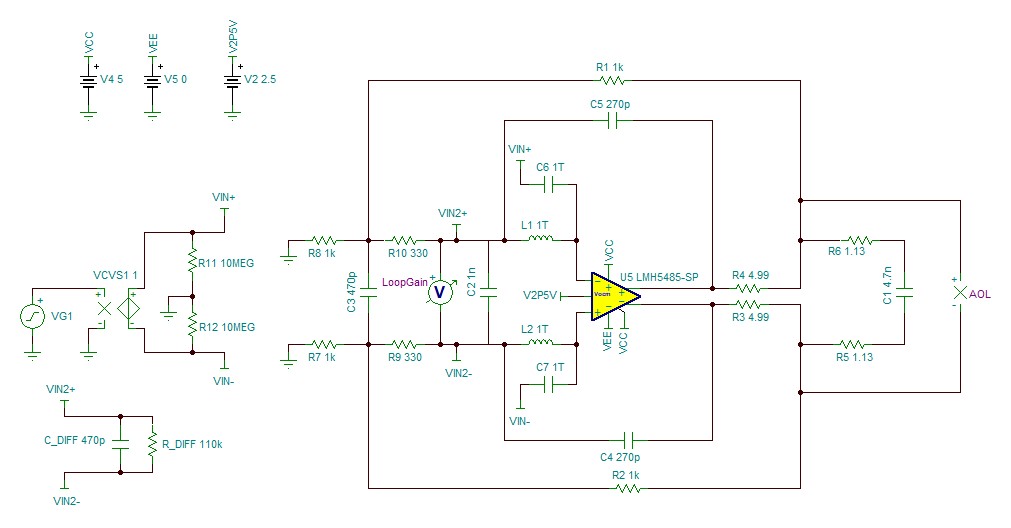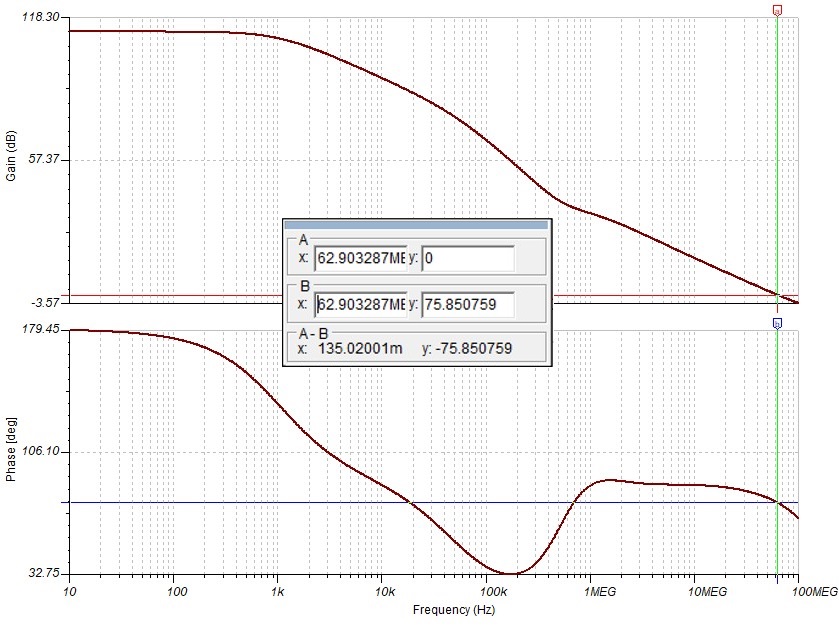SBAA534 March 2022 ADC128S102-SEP , ADC128S102QML-SP , ADS1278-SP , ADS1282-SP , LF411QML-SP , LM101AQML-SP , LM111QML-SP , LM119QML-SP , LM124-SP , LM124AQML-SP , LM136A-2.5QML-SP , LM139-SP , LM139AQML-SP , LM148JAN-SP , LM158QML-SP , LM185-1.2QML-SP , LM185-2.5QML-SP , LM193QML-SP , LM4050QML-SP , LM6172QML-SP , LM7171QML-SP , LMH5401-SP , LMH5485-SEP , LMH5485-SP , LMH6628QML-SP , LMH6702QML-SP , LMH6715QML-SP , LMP2012QML-SP , LMP7704-SP , OPA4277-SP , OPA4H014-SEP , OPA4H199-SEP , THS4304-SP , THS4511-SP , THS4513-SP , TL1431-DIE , TL1431-SP , TLC2201-SP , TLV1704-SEP , TLV4H290-SEP , TLV4H390-SEP
2.4 Stability
Along with the FDA stage, the AFE design contains a closed-loop system that raises the concern for instability causing ringing or even oscillation. The standard way to understand the likelihood for oscillation is to analyze the Bode plot and verify that there is enough phase margin.
Before the FDA stage can be analyzed, it must be isolated from the rest of the circuit and the feedback path must be opened up to allow for extracting the open loop gain as shown in Figure 2-10. In addition TINA-TI must be enabled to properly converge for any frequency, including DC. All this is accomplished by adding capacitors and inductors with Terra values, practically infinite capacity or inductivity, respectively. The huge capacitor acts like a short for any frequency above a few Hertz and as an open for DC. Likewise, the giant inductor acts as a short for DC and as an open for any frequency higher than a few Hertz. Obviously, this is only practical for the simulation. The higher the values that are selected the closer the simulation will remain to reality, the circuit without such added capacitors and inductors.
The output load must stay included so it continues to interact with the output impedance of the amplifier as it would in the complete AFE implementation. The introduction of the large inductors disconnect the input impedance of the op amp from the circuit. R_Diff and C_Diff are therefore added back in to find the correct open loop gain.
 Figure 2-10 Closed-Loop System Extracted
and Prepared for Stability Analysis
Figure 2-10 Closed-Loop System Extracted
and Prepared for Stability AnalysisAs in Section 2.3, the AC Transfer Characteristic in TINA-TI simulator is used to analyze the frequency response for amplitude and phase for the FDA stage in open loop configuration, see Figure 2-11.
 Figure 2-11 Selection of AC Transfer
Characteristic to Analyze the Frequency Response for Amplitude and Phase for the
FDA Stage in Open Loop Configuration
Figure 2-11 Selection of AC Transfer
Characteristic to Analyze the Frequency Response for Amplitude and Phase for the
FDA Stage in Open Loop Configuration Figure 2-12 Bode Plot for the FDA Stage in
Open Loop Configuration
Figure 2-12 Bode Plot for the FDA Stage in
Open Loop ConfigurationThe resulting Bode plot in Figure 2-12 shows sufficient stability with a phase of 75.85° at the crossover frequency of 62.9 MHz. The dip in phase margin at about 150 kHz might allow for some ringing. Remember this issue in case it appears in the actual design.